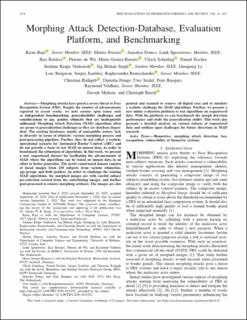| dc.contributor.author | Raja, Kiran | |
| dc.contributor.author | Ferrara, Matteo | |
| dc.contributor.author | Franco, Annalisa | |
| dc.contributor.author | Spreeuwers, Luuk | |
| dc.contributor.author | Batskos, Ilias | |
| dc.contributor.author | Wit, Florens de | |
| dc.contributor.author | Gomez-Barrero, Marta | |
| dc.contributor.author | Scherhag, Ulrich | |
| dc.contributor.author | Fischer, Daniel | |
| dc.contributor.author | Venkatesh, Sushma | |
| dc.contributor.author | Singh, Jag Mohan | |
| dc.contributor.author | Li, Guoqiang | |
| dc.contributor.author | Bergeron, Loïc | |
| dc.contributor.author | Isadskiy, Sergey | |
| dc.contributor.author | Ramachandra, Raghavendra | |
| dc.contributor.author | Rathgeb, Christian | |
| dc.contributor.author | Frings, Dinusha | |
| dc.contributor.author | Seidel, Uwe | |
| dc.contributor.author | Knopjes, Fons | |
| dc.contributor.author | Veldhuis, Raymond N.J. | |
| dc.contributor.author | Maltoni, Davide | |
| dc.contributor.author | Busch, Christoph | |
| dc.date.accessioned | 2022-10-07T11:32:17Z | |
| dc.date.available | 2022-10-07T11:32:17Z | |
| dc.date.created | 2022-01-11T15:23:35Z | |
| dc.date.issued | 2021 | |
| dc.identifier.citation | IEEE Transactions on Information Forensics and Security. 2021, 16 4336-4351. | en_US |
| dc.identifier.issn | 1556-6013 | |
| dc.identifier.uri | https://hdl.handle.net/11250/3024498 | |
| dc.description.abstract | Morphing attacks have posed a severe threat to Face Recognition System (FRS). Despite the number of advancements reported in recent works, we note serious open issues such as independent benchmarking, generalizability challenges and considerations to age, gender, ethnicity that are inadequately addressed. Morphing Attack Detection (MAD) algorithms often are prone to generalization challenges as they are database dependent. The existing databases, mostly of semi-public nature, lack in diversity in terms of ethnicity, various morphing process and post-processing pipelines. Further, they do not reflect a realistic operational scenario for Automated Border Control (ABC) and do not provide a basis to test MAD on unseen data, in order to benchmark the robustness of algorithms. In this work, we present a new sequestered dataset for facilitating the advancements of MAD where the algorithms can be tested on unseen data in an effort to better generalize. The newly constructed dataset consists of facial images from 150 subjects from various ethnicities, age-groups and both genders. In order to challenge the existing MAD algorithms, the morphed images are with careful subject pre-selection created from the contributing images, and further post-processed to remove morphing artifacts. The images are also printed and scanned to remove all digital cues and to simulate a realistic challenge for MAD algorithms. Further, we present a new online evaluation platform to test algorithms on sequestered data. With the platform we can benchmark the morph detection performance and study the generalization ability. This work also presents a detailed analysis on various subsets of sequestered data and outlines open challenges for future directions in MAD research. | en_US |
| dc.language.iso | eng | en_US |
| dc.publisher | Institute of Electrical and Electronics Engineers (IEEE) | en_US |
| dc.rights | Navngivelse 4.0 Internasjonal | * |
| dc.rights.uri | http://creativecommons.org/licenses/by/4.0/deed.no | * |
| dc.title | Morphing Attack Detection-Database, Evaluation Platform, and Benchmarking | en_US |
| dc.type | Peer reviewed | en_US |
| dc.type | Journal article | en_US |
| dc.description.version | publishedVersion | en_US |
| dc.source.pagenumber | 4336-4351 | en_US |
| dc.source.volume | 16 | en_US |
| dc.source.journal | IEEE Transactions on Information Forensics and Security | en_US |
| dc.identifier.doi | 10.1109/TIFS.2020.3035252 | |
| dc.identifier.cristin | 1978607 | |
| cristin.ispublished | true | |
| cristin.fulltext | postprint | |
| cristin.qualitycode | 2 | |

